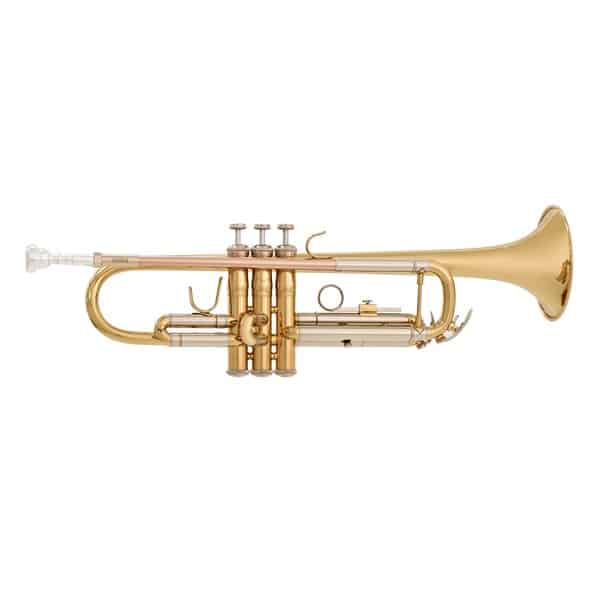Best Overall
Beginner Trumpet
-
Overall: 9/10
-
Best Feature: Durable construction made of yellow brass
-
TedScore™: 9/10
Best Value for
Money
Beginner Trumpet
-
Overall: 9/10
-
Best Feature: Experience a fantastic tone with the rose brass lead pipe
-
TedScore™: 9/10
Best Versatile
Beginner Trumpet
-
Overall: 8/10
-
Best Feature: The lead pipe is easy-blowing and has fantastic tuning
-
TedScore™: 8/10
Playing the trumpet lets you create beautiful melodies and harmonies. Learning about trumpet notes helps you make lovely tunes and express yourself through this brass instrument.
Don’t worry if reading music seems hard at first. With some help, you can easily match the notes on the page with the sounds from your trumpet. It’s easy once you know which valves to press for each note.
By the end of this article, you’ll be playing the right notes easily. Let’s begin making some musical magic together!
Fundamentals of Trumpet Notes
Understanding Trumpet Notes
The trumpet has a range of notes, from the lowest note, C, to the highest note, G. The notes on a trumpet are written in treble clef, a series of five lines and four spaces. Each line and space represents a different note.
For beginners learning to play the trumpet, the first notes they typically learn are the open notes of C, G, and E, which form the foundation for playing melodies and chords in various keys.
Reading Sheet Music
Reading sheet music is an essential skill for any trumpet player.
Sheet music for the trumpet is written in treble clef, a series of five lines and four spaces. Each line and space represents a different note.
The notes on the sheet music are written alphabetically, starting with A and ending with G. The notes are repeated in different octaves, higher or lower versions of the same note.
When reading sheet music, it’s important to pay attention to the key signature, which indicates the notes that are sharp or flat. The time signature is also important, as it indicates the rhythm of the music.
It is also important to pay attention to the dynamics, which indicate the volume of the music. Dynamics are written as letters, such as p for piano (soft) and f for forte (loud).
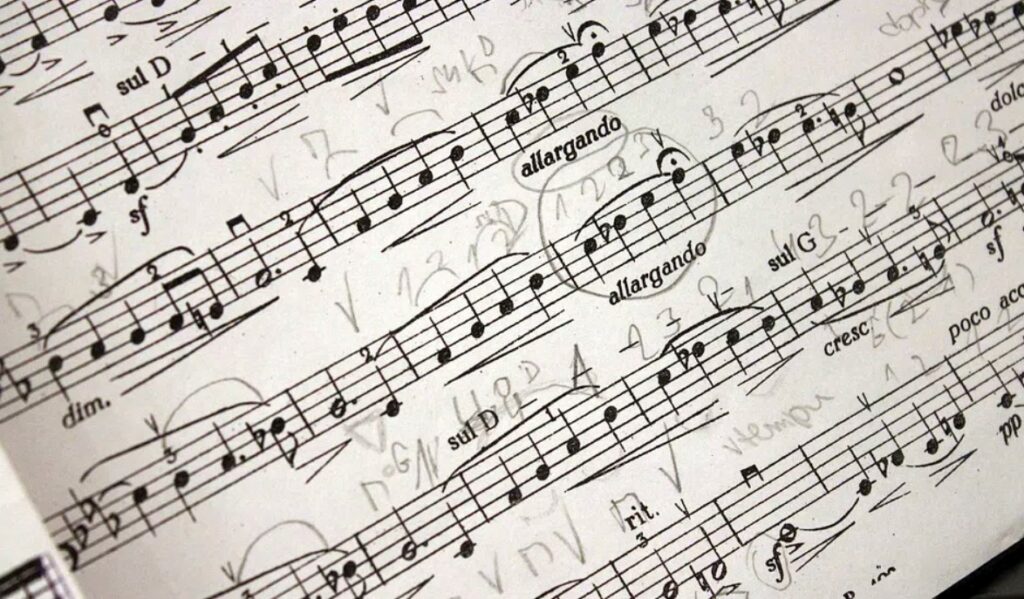

Fingering and Valve Combinations
Basic Fingering Techniques
The trumpet fingering chart shows the most commonly used fingerings for trumpets.
The trumpet sheet music chart can also be used for playing the cornet, flugelhorn, tenor horn, baritone, euphonium (which have three valves), and the tuba (three valves treble clef).
To play the trumpet, you must use your fingers to press the valves down.
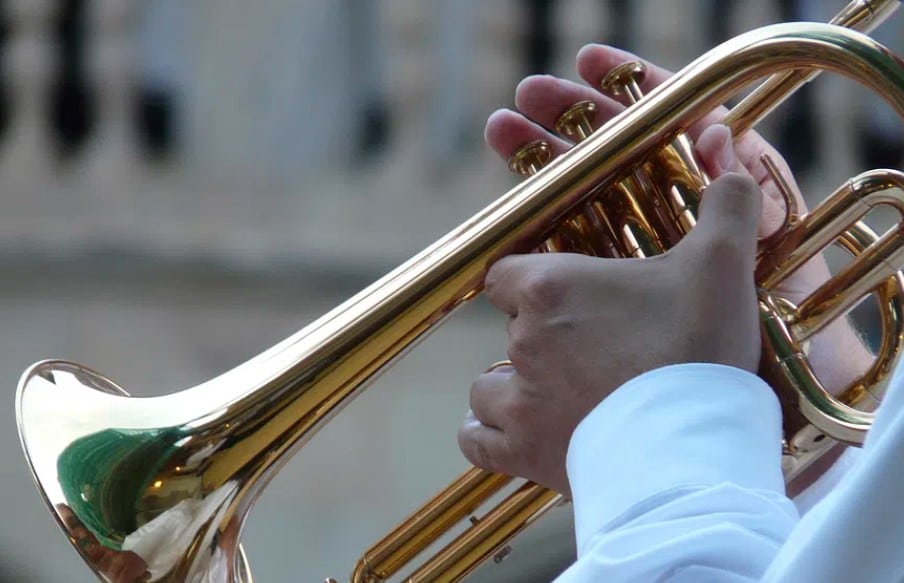
Each valve has a specific note attached to it. The first valve lowers the pitch by a full tone whole step, the second valve lowers the pitch by a half step, and the third valve lowers the pitch by a step and a half.
Valve Combinations
Valve combinations are essential to playing the trumpet. By using different valve combinations, you can play different notes.
You do not need to press any of the valves down to play a C note. Press the first and second valves down to play a C# or Db note.
To play a D note, press the second valve down. Press the first valve down to play a D# or Eb note.
You need not press any valves down to play an E note. To play an F note, press the first valve down.
Press the first and second valves down to play an F# or Gb note. To play a G note, press the second and third valves down.
Press the first and third valves down to play a G# or Ab note. To play an A note, press the first and second valves down. To play an A# or Bb note, press the first, second, and third valves down.

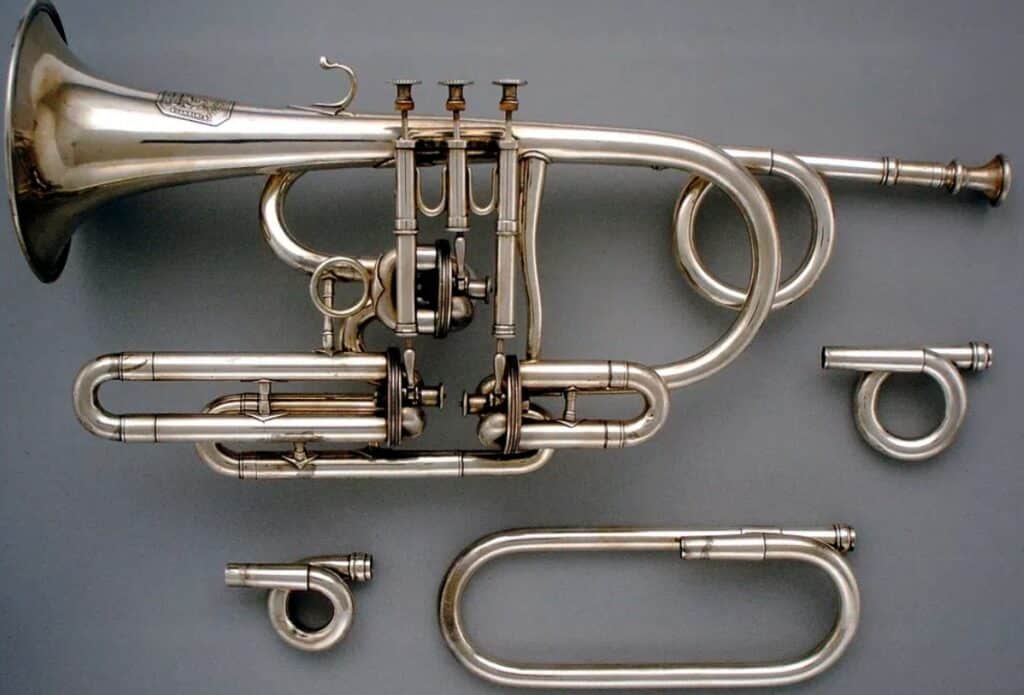
Mastering the basic fingering techniques and valve combinations is essential to playing the trumpet. With practice, you can play different notes and create beautiful music.
Practising Trumpet Notes
Learning to play the trumpet can be challenging, but with dedication and consistent practice, you can master it.
The first thing to do is get a real note out – any real note . Most often the problem is that you’re not using enough air and/or that air isn’t moving fast enough.
Practising trumpet notes is one of the fundamental aspects of learning to play the instrument, so keep reading to learn more.
Practicing Scales
Practising scales is a great way to improve your trumpet playing skills. Scales are a series of notes played in a specific order, and they help you develop your finger technique, tone, and intonation.
Here are some tips to help you practice scales:
Start with the basic major scales, such as C, G, D, and F. Once you have mastered these, move on to more complex scales like Bb, Eb, and Ab.
Use a metronome to maintain a steady tempo and gradually increase your speed. Start slow, and gradually increase the tempo as you improve.
Practice each scale in different octaves to improve your range and flexibility.
Focus on playing each note with a clear and consistent tone. Use a tuner to ensure that you are playing in tune. As you work your way through this set of 5 notes, when playing each note remember to re-form the “M-B” embouchure, place the mouthpiece comfortably centered on your lips, take a deep breath, and blow with the same amount of air pressure you would use to blow out birthday candles.
Practice scales in different rhythms, such as triplets, sixteenth notes, and dotted rhythms.
Practising with Sheet Music
Practicing with sheet music is another essential way to improve your trumpet playing skills. Sheet music provides a structured and organized way to practice different notes, rhythms, and musical phrases.
Here are some tips to help you practice with sheet music:
Start with simple pieces and gradually move on to more complex ones.
Focus on playing each note accurately and with the correct rhythm.
Use a metronome to maintain a steady tempo.
Practice playing along with recordings of the piece to improve your timing and phrasing.
Use a tuner to ensure that you are playing in tune.
Break down the piece into smaller sections and practice each separately before putting them together.
Our Best Trumpets for Beginners
Bach TR650 Bb Trumpet Outfit, Clear Lacquer
When you check the price above, you’ll see there are loads of great places to buy this item. Our personal favorite is Gear4music.
It is the largest music retailer in the UK and fast becoming the most respected online music shop in the US too. Their customer service is excellent, they have competitive prices, really fast shipping, and usually have the longest guarantee.
Most professional musicians use Gear4music, so there is no reason why you shouldn’t too!
- Includes everything you need to get started
- Rose leadpipe produces a fantastic tone
- Designed by the famous Vincent Bach company
- Steel valves are light, smooth, and durable
- Includes backpack-style case and mouthpiece
- None
The professional musician who wrote this article combined many things,
from the product build, manufacturer’s reputation through to feedback
from other users, to create our famous TedScore™.
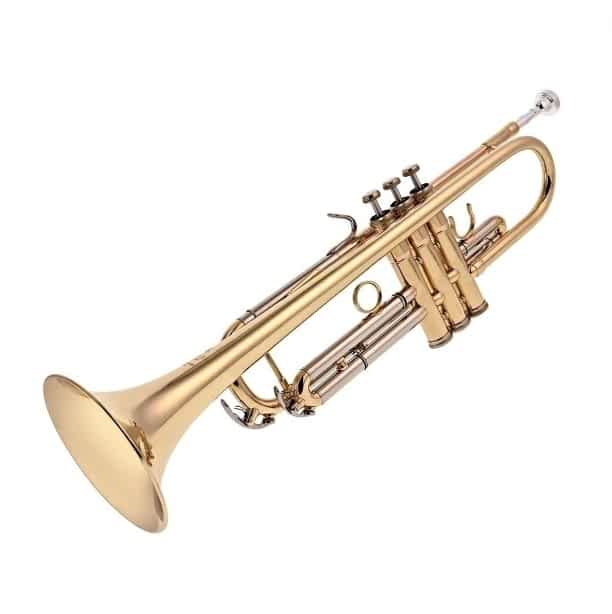
FEATURES:
1. The smaller valve block makes it
easier to grip the trumpet
2. The lead pipe is easy-blowing
and has fantastic tuning
OTHER INFO: Text
Besson BE110 New Standard Bb Trumpet Package, Clear Lacquer
When you check the price above, you’ll see there are loads of great places to buy this item. Our personal favorite is Gear4music.
It is the largest music retailer in the UK and fast becoming the most respected online music shop in the US too. Their customer service is excellent, they have competitive prices, really fast shipping, and usually have the longest guarantee.
Most professional musicians use Gear4music, so there is no reason why you shouldn’t too!
- Everything you need to get started is included
- Designed specifically with beginners in mind
- Slightly more expensive compared to other brands
The professional musician who wrote this article combined many things,
from the product build, manufacturer’s reputation through to feedback
from other users, to create our famous TedScore™.

FEATURES:
1. Durable construction made of yellow brass
2. The adjustable 3rd trigger
ring ensures a comfortable grip
OTHER INFO: Text
Yamaha YTR2330 Student Trumpet
When you check the price above, you’ll see there are loads of great places to buy this item. Our personal favorite is Gear4music.
It is the largest music retailer in the UK and fast becoming the most respected online music shop in the US too. Their customer service is excellent, they have competitive prices, really fast shipping, and usually have the longest guarantee.
Most professional musicians use Gear4music, so there is no reason why you shouldn’t too!
- Comes with a gig bag and mouthpiece
- Register and enjoy a 5-year extended warranty and 3-month Tomplay Premium
- May be too pricey for beginner players
The professional musician who wrote this article combined many things,
from the product build, manufacturer’s reputation through to feedback
from other users, to create our famous TedScore™.
Trumpet Notes: Final Thoughts
Summary
As we wrap up our journey through trumpet notes for beginners, I hope you feel a bit more confident and ready to tackle your next practice session. The trumpet may seem tricky, but it becomes a joyful experience with patience.
Here’s a nifty breakdown of what we’ve covered:
- Basics of Trumpet Notes: We started with the basic notes like C, G, and F and their corresponding fingerings.
- Finger Technique: Getting the hang of different fingerings is key. For example, press the first valve for A#/Bb and the second for B.
- Building Embouchure Strength: Strengthening your embouchure helps with note clarity and endurance.
- Utilizing Mnemonic Devices: These are handy tools for memorizing notes and their fingerings.
- Scales and Arpeggios Practice: Regular practice with scales and arpeggios enhances your musical range and skill.
- Training Your Ear: Listening and playing by ear aid in refining your musicality and precision.
- Seeking Guidance: Don’t hesitate to seek advice from more experienced players or instructors.
Playing trumpet notes combines practical skills, theoretical knowledge, and passion for the instrument. Keep practicing, stay committed, and enjoy the music you create!
Wait, there’s more!!!
Buckle up and prepare to jazz things up with these 13 Trumpet Accessories!
From funky mutes to snazzy mouthpieces, we have everything you need to add some pizzazz to your playing!
FAQ's
To learn the notes on a trumpet, you need to first memorize the fingerings for each note and then practice playing those notes until they become second nature. You can use a fingering chart and a tuner to help you learn and perfect each note.
A standard trumpet can play a range of approximately three octaves, which includes around 40 to 50 individual notes. However, the actual number of notes that a trumpet can play depends on the skill level and technique of the player.
B flat is a common note in trumpets and is the pitch that the instrument is typically tuned to. It’s the second-to-lowest note that can be played on a standard B flat trumpet and is often used as a reference note for tuning the instrument.




